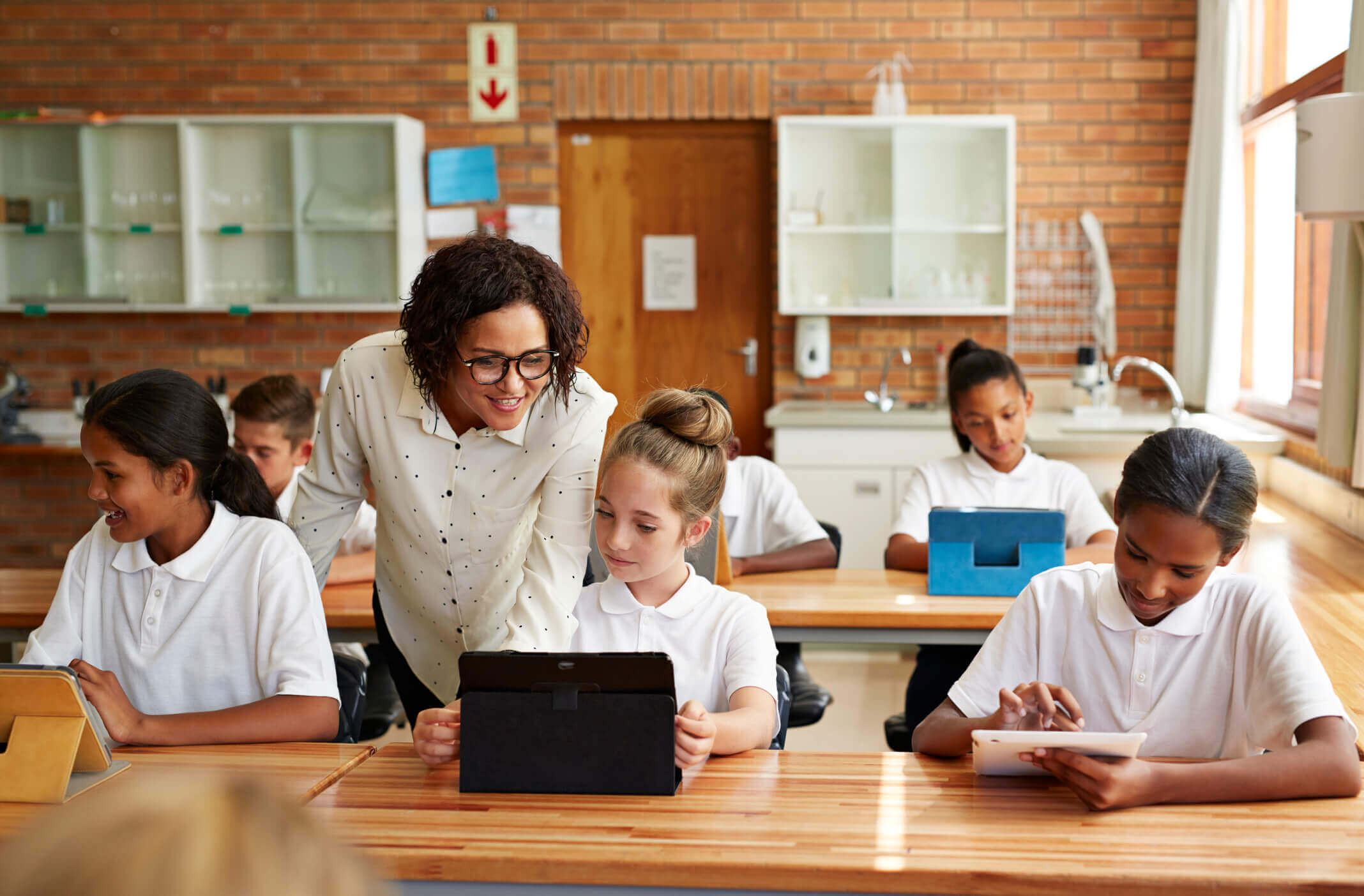Published on April 4th, 2023
10 Tips on How to Monitor Student Engagement
15 minute read

In educational environments, from early years all the way up to Higher Education, monitoring student engagement is essential to ensuring success. This can be achieved through various methods, such as observing student participation in classrooms to conducting student-led surveys.
When you monitor student engagement, you’ll collect cognitive, behavioural, and emotional experiences and data. This helps to accurately assess engagement to date, analyse past teaching strategies, and develop new ones to boost engagement even further going forward.
In this article, we’ll explore 10 tips for how you can best monitor student engagement.
What is student engagement?
Engaged students don’t only absorb what they learn in the classroom; they make their studies meaningful by applying their intellectual efforts in coursework, exams and real-life situations. These students work through challenging ideas, actively considering and evaluating an assignment to formulate the best solution. If students are fully engaged, they’ll care about the subject and be enthusiastic and motivated to learn more.
Engagement in classrooms doesn’t only refer to student participation through asked and answered questions, though. Student engagement is far more involved than that.
Students show how engaged they are through complex and interconnected behavioural, emotional, and cognitive interactions with their teachers and classmates. These work together to influence their engagement with a particular topic or at a specific time. As educators, it is our responsibility to tune into these signals and assess how we can work with our students to meet their needs and keep them engaged throughout the academic year.
10 tips to monitor a student’s engagement
There are several ways to monitor student engagement at both individual and group-level. These tips will help you assess how students operate in the learning environment.
You’ll learn how to identify areas of student support that may need improving if you’re to maintain engagement and discover the different tools that can assist you in refining teaching methods where necessary.
Let’s look at these 10 methods of assessing student engagement through the learning process:
1. Set ground rules and boundaries
One way of creating engagement in a classroom is by establishing an open and honest communication platform with your students.
You can start by introducing classroom discussions with clear ground rules so that everyone feels able to contribute without fear of judgement or punishment. Follow this by encouraging your students to join you in working to establish these; you’ll be quite impressed with the level of student support you receive simply by asking for their involvement.
These discussions create a rapport between you and your students. They’ll encourage students’ active involvement in setting boundaries by creating opportunities to improve engagement. You’ll also identify non-participating students or those not putting in the required mental effort. This method can be applied to students of all ages.
2. Observe classroom participation
The most basic way to assess student engagement is to simply watch how they contribute to classroom discussions. You can encourage participation by asking questions and leading group discussions. When projects are due, ask for volunteers to present their assignments to their peers. If students are reluctant to step up and share their work with an audience, you could always make the presentation element a part of the assignment itself and make it so that a part of their final grade is dependent on them communicating their ideas and findings effectively.
These methods will help you engage students more and identify those needing extra encouragement. Monitoring classroom participation is especially effective with children in the foundation phase, whilst using presentations is more appropriate for older students.
3. Small group participation
You’ve likely found that more introverted students are uncomfortable speaking up in large groups. These students will also be hesitant to present work in front of all their classmates. With these learners, improving student engagement may come from dividing them into smaller groups.
Introverted students may become more engaged in these types of settings. These groups allow you to observe which students are attentive and involve themselves in the learning material. Likewise, you’ll notice which are not interested at all. Group participation levels provide the most insight into students in higher or further education stages.
4. Gamification
Sometimes, it isn’t easy to assess student engagement while presenting a lesson. While you may have some idea of the students who are happy to participate and engage with the course content, it’s not always clear who might be feeling disengaged or withdrawn.
A points system that rewards student participation makes it easier to assess engagement. You can award points for answering questions or providing examples of taught concepts, for example. Another way to measure engagement through gamification is by rewarding points for completing extra work.
By turning your lessons into a game with a point or prize-based rewards system, students will have additional motivation to get involved and go out of their way to show you that they are engaged.
Struggling with inspiration for ways to introduce games into your lessons? We’ve got plenty of ideas ready for you to use, alongside our ultimate list of classroom games:
- Classroom English Games
- History Games for Interactive Whiteboards
- Computing Games for Interactive Whiteboards
5. Icebreakers
Coming up with well-timed collaborative activities such as ice-breakers helps you in monitoring student engagement. They can prove hugely effective in breaking down communication barriers between students and even encourage less confident individuals to speak up and share their ideas with classmates.
Whilst asking students to participate by standing at the front of the classroom and presenting their work can, sometimes, induce anxiety, ice-breakers are far less intimidating. This means that they can help to bring shyer students out of their shells and push them into participating more in future tasks or group interactions.
6. Quizzes
Setting regular quizzes at the end of modules or schemes of work can provide valuable insights for teachers into the extent to which individual students have engaged with the course content.
If students aren’t achieving the grades you expect on quizzes, it’s likely they won’t be in formal tests or examinations, too. These students are prime targets for re-engagement strategies, as a little extra support on specific topics or concepts can go a long way in putting them in the best possible position to achieve their potential when exam season comes around.
7. Journalling
There’s a well-known story linked to improving student engagement through journaling. Teacher Erin Gruwell encouraged learners to write their own stories as a way of improving student engagement in her classes. The resulting contributions were subsequently brought together into a book and feature-length film!
Gruwell inspired her students by encouraging them to journal their own stories. Through the process, she could track and accurately assess student engagement in her classes. With journalling as her tool, she engaged students on a level they understood. They became actively involved, thus growing their participation levels.
8. Go outdoors
There’s no doubt that some students respond better to aural learning. Others will gain more knowledge from physical learning than through reading and revision. Then there are students that rely on their visual sense to make the most ground with learning tasks.
For these students alone, occasionally going outside into a natural environment can awaken their senses. Renewed concentration and engagement follow upon returning to the classroom, meaning the benefits of taking a quick break from the same four walls can have huge benefits long afterwards. You could try this to judge its effectiveness by holding part of your lesson outside before returning to the classroom for a period of focused study. Use the earlier methods of observing participation and small group work to see whether your students engage better when you go back inside.
9. Use mixed media
Each and every student learns differently, with some absorbing information more easily in certain situations than others. Because no two students will ever learn with exactly the same method, try to present your lessons to appeal to an array of learning styles; auditory, visual and kinesthetic.
You could make learning physical by bouncing a ball while reciting times tables or using a stuffed animal as a mascot that is thrown between students as you nominate individuals to answer questions. Playing educational audio recordings or videos can vary your lessons. The more variety you add, the more accurately you’ll assess student engagement. Doing so means you will be able to adapt your teaching methods to suit the best outcomes.
10. Technology
Technology in the classroom can’t, and shouldn’t, be ignored, especially in the tech-centric world of today. Today’s students are from a generation that has grown up surrounded by technology in all aspects of their lives and so expect it to be a feature of their learning environments, too. There are plenty of methods to help you engage students using technology.
With students entering the education system already familiar with a wide range of technologies and digital aids, supplying them with a familiar learning method improves overall engagement. People gravitate to what they know, and classroom content projected in a familiar way means more engaged students.
Just be mindful that not all students will have had access to the same opportunities or resources growing up. Monitor whether any of your pupils seem to be struggling to get to grips with the technologies you’re providing, and offer additional support if needed so they don’t get left behind.
Advanced interactive solutions to engage students
We’ve mentioned that a key way to keep students engaged is to incorporate technology into the classroom. Whiteboards and interactive displays are integral interactive tools that monitor, assess, and improve engagement with in-person and hybrid classroom environments.
Modern teaching strategies incorporate solutions like Promethean’s ActivPanel. The tool provides intuitive learning experiences designed to engage students on far greater, more profound levels than ever before.
Teaching priorities are turning more towards collaborative work in the classroom with every passing day and interactive solutions for assessing student engagement and improving learning outcomes are becoming integral to group activities.
Keep up with the latest teaching trends and stay on top of your student’s learning by incorporating technological aids into your lessons. Request a demo of Promethean’s range of solutions to learn how interactive displays and software can enhance your teaching methods, boost engagement and improve grades among your pupils.
Ultimately, by actively engaging their students, teachers allow them to take charge of their own learning. By empowering the student to pay attention to the material presented in the classroom, you’re making the learning process more easily navigable for your student – and the teaching role easier for yourself.
FAQs
What are some strategies for maintaining student interest during lessons?
Teaching strategies for keeping students engaged include the use of interactive technology. Encouraging student collaboration also supports and improves engagement.
How can you identify students that aren’t properly engaged?
There are several ways to identify a student that isn’t learning tasks or responding to teaching methods. Some of these include observation, surveys, and student self-report guidelines.
Why is student engagement important?
Engagement in students is essential as it is connected to academic achievement and student success. Motivated students will likely attend class, take part in discussions and finish assignments. This all contributes to greater success in assessments.




